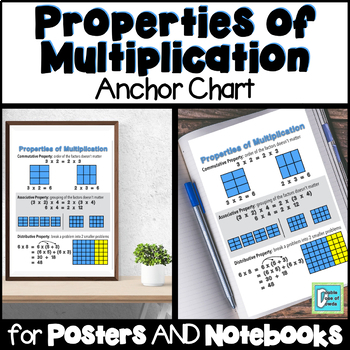Properties of Multiplication Anchor Chart for Interactive Notebooks and Posters
- Zip
Also included in
- Looking for MATH ANCHOR CHARTS to help your students visualize every major topic in your 3rd grade math classroom? Hang these on the wall as POSTERS and give students copies for their INTERACTIVE NOTEBOOKS. We keep anchor charts simple and neat so as not to overwhelm students and help keep them focuPrice $16.50Original Price $48.50Save $32.00
- This PROPERTIES OF MULTIPLICATION UNIT BUNDLE includes a PowerPoint lesson, anchor chart, six math center games, three leveled worksheets, BINGO, and a cooperative learning game! It is everything you need to teach the zero, identity, commutative, associative, and distributive properties of multiplicPrice $27.16Original Price $34.45Save $7.29
Description
This anchor chart for properties of multiplication will help your students visualize the difference between the commutative, associative, and distributive properties. We prefer to keep anchor charts simple and neat so as not to overwhelm our students and to keep them focused on essential information. This is a one-page anchor chart that comes in a variety of formats including a single sheet, half sheets (great for interactive notebooks), and a 2x2 POSTER. The poster will print on 4 sheets of paper which you will need to trim and tape to form one large poster.
If you like this anchor chart, you may be interested in purchasing our entire set of 18 Anchor Charts (including this one) at a deeply discounted price:
⭐⭐⭐ 3rd GRADE ANCHOR CHARTS BUNDLE ⭐⭐⭐
We also have Math Anchor Chart Bundles for:
What teachers are saying about this product:
♥ "I love this anchor chart. It is clear and precise. The kids use it effectively."
♥ "Great visuals that the kids have added to their interactive notebooks. Thanks for the great resource that they can refer to over and over again!"
♥ "Great way to sum up a tough concept. I'm having the kids add it to their interactive notebooks."
♥ "Went right along with our math curriculum and was able to make a small copy for each student as well!"
You might also like:
Properties of Multiplication Grocery RACE
Multiplication Fact Tricks Anchor Chart
Associative Property Task Cards
Commutative Property Match-Up Cards
Distributive Property Task Cards
Properties of Multiplication Math Centers Bundle
Multiplication Word Problems Task Cards
Click here to FOLLOW US and get 50% off our new products for the first 24 hours.
Connect with us:
♥ Newsletter FREEBIES ♥ YouTube ♥ Facebook ♥ Instagram ♥ Pinterest ♥ Blog ♥
Purchasing this product grants permission for use by one teacher in his or her own classroom. If you intend to share with others, please purchase additional licenses at the discounted rate when you checkout.
We TRULY appreciate your purchase and remind you that leaving feedback earns you TpT credit toward future purchases! If you have any questions, please feel free to contact us.
Thanks so much!
Clint & Alyson Dowda







